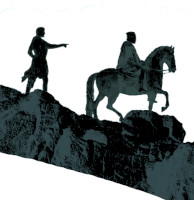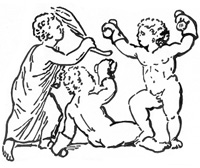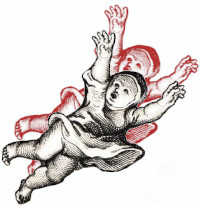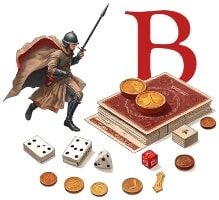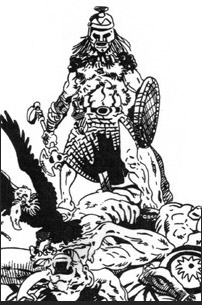The religious personalities who did battle over Christian doctrine included the martyred Cyprian, the scholars Eusabius, Augustine, Athenasia [famous from Ethiopia to Britain, who had the mind to run an empire but fought heresy instead], Basil, Osius an Iberian bishop and favorite of Constantine and one Arius, whose doctrine caused a good hundred years of feuding within the Christian Church.
Constantine encouraged the greatest fanatic minds of his time to do battle in church synods, as he asked naive to practical questions concerning matters far out of his debt. He might have honestly been trying to learn the truth by way of using his power to gather the foremost authorities to debate before him as he humbly sat his stool. Or, might he have simply been thrilled that trouble being made concerned the next life and not his empire on earth?
Two things are certain:
>1. Constantine and his successors did not decline ratification under the old gods until Gratian succeeded in 367, 30 years after the death of Constantine, and 42 years after the first council of Nicea.
>2. It would take the rest of the century to sort out the Orthodox doctrine, with an additional council held in Constantinople in 381. Such doctrinal councils would be held throughout the Middle Ages. These never satisfied all parties and splits in the faith would continue well into modern times.
Constantius II ruled the empire until 361. Not the rugged soldier his father or grandfather was, he had generals do his fighting and encouraged numerous synods, or theological debates. He did a disservice to Christianity and to The Empire as he made of his father’s policy a theater. Elections of bishops and archbishops were as corrupt as any political election in American labor politics. Gibbon makes certain that we never forget the hand of the eunuchs behind the scenes in all of these religious persecutions.
Before considering the origins of this debate, a portrait of the great city built, as it seems, to conduct this debate on earth about heaven above.
Founded in A.D. 29, the city originally contained:
-Jupiter’s Baths
-14 churches
-14 palaces
-322 streets
-3888 great houses
-A wooden statue of Constantine
-A brazen statue of Apollo, taken from a plundered pagan temple.
There were economic and military reasons for founding the new capital at the Golden Horn, where the Black Sea violently discharges into the Aegean. This was an important passage mythically and historically. The most important consideration was probably proximity to the Egyptian grain supply and the Persian enemy, which was the most competent and intractable foe of Rome.
However, Egypt was ever so important to the soul of the Empire:
>1. Plato had learned theology in Egypt, and the Platonic school in Greece was the source of the Christian doctrine of the Holy Trinity, of the Triumverate Godhead: The First Cause [God the Father], the Logos [the Son] and the Spirit.
>2. Various sects of fanatical religionists, including Christian denominations, teamed in Egypt.
>3. The most popular man in Egypt was the saint like archbishop Athenasia, whose parishoners were willing to go to war for.
>4. Hellenistic Jеwish scholars had schools in Alexandria which were influential in the Christian world, for the Christian world was, by the mid 100s, first, and foremost, Greek. [0]
From the view of a war fighter of the northern frontiers like Constantine, facing beatable but inextinguishable barbarians and possible rivals within the empire, in the east he faced the religious fanatics of Magi Persia, who were closer to his food supply than his posts on the Rhine and the Danube. And, his work force and managerial class in Egypt, producing and guarding and shipping his food supply, were also religious fanatics, fractious fanatics.
The founding of Constantinople was a conversion of physical and metaphysical internal lines, to include the balancing schools of philosophy in Athens, from whence his surviving son’s chosen successor, Valentinian, would be educated.
The first Christian doctrine, referencing the Holy Trinity was from about A.D.140 by the Bishop of Antioch, Theopolis. The Platonists were thrilled with the Gospel of John, who they claimed as one of their own. There was also a belief among some early Roman Christians that Virgil had predicted the coming of Jesus Christ just one generation before his birth. [1]
Constantinople was dedicated to The Mother Mary, something that would horrify modern Protestants, and indicates the metaphysical concerns of an emperor defending the fertile center of the known world from rapacious enemies. The Cult of Mary is easily understood as a compromise with pagan tradition, of honoring the motherland, and is traditionally made to fit in with the Holy Spirit aspect of the Trinity.
The mind-boggling hair-splitting of the various sects was most pronounced in North Africa, where actual religious wars broke out between Orthodox/Catholic [2], Manicheans, Marsianites, Valentinians, Donatists [3], the Arrians [4] in no less than 18 factions, the Montanists, the Novations, the Maxianists [5], and even the tiny sect of the Rogations based in what is now Morocco.
The weapon was excommunication. This great rod of damnation was alternately pointed at one sect by another with the deranged brat emperor Constantius II jeering on the debate. The bishops spent so much time on the road to these synods [6] that their ministries were neglected.
This was such an age of pain-wracked sorrow, that many excommunicated Christians in North Africa became bandits, others “excommunicated the world,” and still others became wandering suicides, seeking out pagans and attacking them so that they could be martyred and get to heaven!
The greatest disagreements came down to the definition of Plato’s concept of The Divinity as a Trinity of Uncaused Creation, Reason, and Spirit that was “of one substance of a kind.” This generally came down to arguments about the physical nature of Jesus Christ.
In the short term it was worth torturing and killing fellow Christians over. In the long term, although indigenous Christians would survive in Egypt, Judea, Syria, Turkey, Spain and Portugal, the bitterness of sectarian Christian hate in North Africa was such that no shred of the faith remained after the sword of Islam passed through. Might this have something to do with the fact that North Africa was not a military zone, that there had been no military threat in that portion of the Roman Empire since the days of the Republic, that between the defeat of Carthage and the invasion of the barbarians 600 years had lapsed? Was there ever a zone of the world so free from external threat for so long?
Must active minds without external enemies manufacture enemies within?
Yet, the most storied bishop of the age, variously exiled, condemned, regarded as a living saint, pardoned by various authorities, the most implacable foe of the creeds of Arius, who served as in the clergy as deacon and Bishop for 46 years, Athenasius, spoke to birds. Yes, the man shared the divination of Apollo—even of Odin—was known by friends and foes to consult the crows.
I am somewhat pleased, to find the ancient world too complex for all the scholars of modernity to unravel sufficiently for our small minds to encompass.
…
Notes
-0. See the Book of Solomon in the Catholic Bible and the work of Philo of Alexandria.
-1. Dante chose Virgil, having become a saintly ghost, as the guide of the infernal regions for Inferno. It is this reader’s opinion that Ovid begged for such a Savior in his melancholy Metamorphoses, written at nearly the same time, a contemporary of Virgil and Jesus.
-2. At this point that was one in the same as the great Latin/Greek schism had yet to occur.
-3. The second largest sect of heretics in this era, with 400 Bishops.
-4. The largest heresy every faced by the Church.
-5. These were 25% of the Donations, who hated the rest rabidly.
-6. Synods were sacred Greek fraternities, first of athletes, under Roman rule from about 100 B.C.


